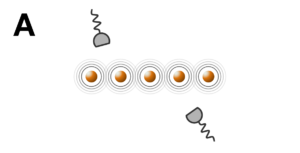Area A: Quantum cooperativity induced by measurement processes
Summary of the area
The common denominator of all projects in area A is to understand and characterize the role of the quantum measurement in determining quantum cooperative dynamics. At its core is the investigation of how measurement and measurement back action establish quantum correlations, and how the emerging correlated states are robust against perturbations by the environment. The range of quantum platforms employed for the experiments in area A display a rich diversity, i.e., trapped ions, color centers in diamond, organic molecules, coherent electrons, spin ensembles and x-ray photons.
Projects
- A01 – Cooperative light emission and spatio-temporal photon correlations from trapped ion arrays
- A02 – Generation of photonic cluster states from color center-cavity systems
- A03 – Correlated x-ray photons for incoherent diffraction imaging
- A04 – Spatio-temporal correlations of electrons emitted from femtosecond laserdriven needle sources
- A05 – Cooperative effects of a defined number of organic molecules embedded in a dielectric antenna
- A06 – Tailor-made beyond-one-excitation quantum states for quantum information and communication
Publications
2023
- , , , , :
Strong-field electron emission from gold needle tips
In: Journal of Vacuum Science & Technology B, Nanotechnology and Microelectronics 41 (2023), Article No.: 052803
ISSN: 2166-2754
DOI: 10.1116/6.0002916 - , , , :
Optical measurement of the work function and the field reduction factor of metallic needle tips
In: Review of Scientific Instruments 94 (2023)
ISSN: 0034-6748
DOI: 10.1063/5.0165802 - , , :
Few-electron correlations after ultrafast photoemission from nanometric needle tips
In: Nature Physics (2023)
ISSN: 1745-2473
DOI: 10.1038/s41567-023-02059-7 - , , , :
Collective photon emission of two correlated atoms in free space
In: Physical Review Research 5 (2023)
ISSN: 2643-1564
DOI: 10.1103/PhysRevResearch.5.013163 - , , , , , , , :
Gottesman-Kitaev-Preskill qubit synthesizer for propagating light
In: npj Quantum Information 9 (2023), Article No.: 98
ISSN: 2056-6387
DOI: 10.1038/s41534-023-00772-y - , , , , , , , , , , , , , , , , , , , , , , , , , , , , , , , , , :
Imaging via Correlation of X-Ray Fluorescence Photons
In: Physical Review Letters 130 (2023), Article No.: 173201
ISSN: 0031-9007
DOI: 10.1103/PhysRevLett.130.173201
2022
- , , , :
Engineering of spontaneous emission in free space via conditional measurements
In: Physical Review Research 4 (2022), Article No.: 043022
ISSN: 2643-1564
DOI: 10.1103/PhysRevResearch.4.043022 - , :
Dicke-like superradiance of distant noninteracting atoms
In: Physical Review A 106 (2022)
ISSN: 1050-2947
DOI: 10.1103/PhysRevA.106.053712 - , , , , , , , , , , :
Coherence of a charge stabilised tin-vacancy spin in diamond
In: npj Quantum Information 8 (2022), Article No.: 45
ISSN: 2056-6387
DOI: 10.1038/s41534-022-00552-0 - , :
Coulomb Interactions and the Spatial Coherence of Femtosecond Nanometric Electron Pulses
In: ACS Photonics (2022)
ISSN: 2330-4022
DOI: 10.1021/acsphotonics.2c00839 - , , , , , :
Coherent Transfer of Transverse Optical Momentum to the Motion of a Single Trapped Ion
In: Physical Review Letters 129 (2022), Article No.: 263603
ISSN: 0031-9007
DOI: 10.1103/PhysRevLett.129.263603
2021
- , , :
Different types of coherence: Young-type interference versus Dicke superradiance
In: Physical Review A 104 (2021), Article No.: 052401
ISSN: 1050-2947
DOI: 10.1103/PhysRevA.104.052401 - , , , :
Optical Superresolution Sensing of a Trapped Ion’s Wave Packet Size
In: Physical Review Letters 127 (2021), Article No.: 143602
ISSN: 0031-9007
DOI: 10.1103/PhysRevLett.127.143602 - , , , :
Imaging Trapped Ion Structures via Fluorescence Cross-Correlation Detection
In: Physical Review Letters 126 (2021), Article No.: 173602
ISSN: 0031-9007
DOI: 10.1103/PhysRevLett.126.173602

